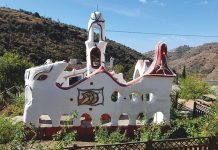Spring is in the air at Seville when the city comes alive for its April Fair – the sweet aroma of orange blossom pervades the air, and a shiver of anticipation runs down, as the city’s most important event takes place.
Traditionally, the Seville April Fair starts at midnight, and after a week long celebration the festivities end with a fireworks display, also at midnight. The event site is the ‘Real de la Feria’, which becomes a city in its own right for the week owing to the extent of this fair.
The grand opening of “La Feria de April” is done with “El Alumbrado” (the lighting)which means the official lighting of the lanterns where half a million little lights are turned on at once, especially at the main gate.
People dress in traditional costumes — not only on the fairground but in the city as well. It’s wonderful and bizarre to see woman in cosuimes of the 18th century.
Watch out for the traditional carriages drawn by horses carrying local girls clad in bright and colourful flamenco dresses through the city streets, set up your ‘casetas’ (marquee tents) at the all night flamenco parties, and wander through the spectacularly decorated tents splurging wi
th food, music and dancing.
The fiesta…
The Seville April Fair centres on the flamenco, horses, and bullfighting, making it a typical Spanish affair! Each day the fiesta begins with a parade called the ‘Paseo de Caballos’ where local girls in their flamenco outfits are carried through the city in striking carriages pulled by horses. In the evening there are bullfights at the La Real Maestranza – best avoid this area if you find bullfighting repulsive.
Inside the casetas
There are thousands of decorated ‘casetas’ set up at the fairground, some of which belong to the well-known people of Seville. Everyone is not allowed inside the casetas, it’s a private pavilion and only relatives and invitees can enter. Most of the casetas have ongoing flamenco performances, loud music, partying and dancing, and drinks and tapas being served.
Seville’s April Fair was started in 1846, surprisingly, by two none-sevillians, a Basque and a Catalan. The main purpose of these two industrious founders was no other than to improve business (trade and agriculture)!




















